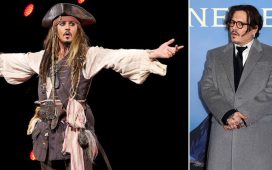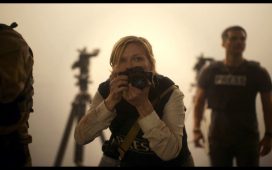Has the Marvel Cinematic Universe entered its flop era? From a box office perspective, certainly not: the mounds of money amassed by Thor: Love and Thunder this past weekend – and the records shattered by multiple generations of Spider-Men last Christmas – prove that the public hasn’t lost its appetite for these quippy, interconnected spandex spectacles. Yet the reviews and even the reactions of opening-night audiences tell a different story: the tale of a franchise too big to fail skidding into its roughest creative patch.
Over the last year, Disney has released a whopping six new Marvel movies. Each has been plagued by its own problems, familiar to the MCU but amplified: perfunctory CGI climaxes (Black Widow and Shang-Chi and the Legend of the Ten Rings), boring ensembles (Eternals), convoluted homework plots (Doctor Strange in the Multiverse of Madness) and complete tonal incoherence (Thor: Love and Thunder). The best and most popular of the bunch, Spider-Man: No Way Home, has the novelty of an exchange program, pulling fan favorites from other continuities to provoke standing ovations. But it also has muddy green-screen action and an overstuffed, MacGuffin-heavy story.
There’s a certain sweaty desperation to the films of what Marvel calls, in corporate boardroom parlance, phase four of its continuing crossover event. These are tentpole entertainments that strain for laughs and excitement. They offer disappointing sendoffs for old characters, like Scarlett Johansson’s super cipher, Black Widow, and Elizabeth Olsen’s trauma-twisted Scarlet Witch, while botching the introduction of new ones. They transparently pander to their fanbase, screeching to a halt (and pausing for applause) during literal cameo parades. And they reinforce the limitations put on their directors, whose much-vaunted location shooting or stray flashes of zombie slapstick can’t disguise the rigidity of the overarching modus operandi.
In theory, it’s not such a bad thing that Marvel appears to be operating, for once, without an explicit, giant event on the horizon. After all, didn’t these films once seem a little too chained to the architecture of their grand design, at times feeling like glorified trailers for some exciting movie you’d have to wait until next summer to see? Yet it’s not as though Marvel is suddenly investing in standalone, self-contained adventures. It’s still tying up plot threads (including ones left hanging on television) and teasing future ones via post-credit stingers. The films remain fundamentally serialized in nature, but without the urgency of a, well, endgame. And that has only underscored the impression of a content mill, churning out stories without much in the way of a purpose or plan.

Of course, the movies released by this studio have always been shiny, zippy product – a collection of splash-panel action-comedies animated less by any spark of grand inspiration than the brilliant synergistic business strategy of linking them all together. The very thing that’s made Marvel movies so successful is also what’s prevented them from rising above a certain ceiling of proficient fun: they’re designed to be familiar and digestible, to offer tweaked variations on a model audiences already love and have come to expect.
There just used to be more bloom on that rose, more promise of sturdy entertainment in the blueprint. Five years ago, Marvel filled a year of release dates with the Guardians of the Galaxy sequel, the first of its Spider-Man movies, the laugh riot Thor: Ragnarok, and the bona fide phenomenon (and Oscar winner) Black Panther – a string of hits that demonstrated how the tried and true template could be bent without breaking. These were movies that made good on the promise of a shared sandbox, a place where film-makers could play around a little with the Avengers action-figure line, edging the larger arc forward while still indulging a few of their own visual and thematic interests.
The new Marvel movies aren’t devoid of personal or idiosyncratic touches. (If anything, the new Thor is possibly too identifiable, in its flaws, as the work of Taika Waititi.) But they do feel more compromised. Each has demonstrated, in its own way, the checks put on anyone hoping to make a movie in this world; what’s infrequently, nominally fun about them – the spy-family sitcom reunion of Black Widow, the martial-arts flourishes of Shang-Chi, the occasional Raimi-isms of Multiverse of Madness – feel at odds with the demands of the larger formula, the stuff a Marvel movie has to do.

Plus, Disney is really draining that formula dry. “Marvel fatigue” is an expression people were using long before this particular bumpy chapter in the studio’s history, but it’s especially applicable to a time when no more than a month or two passes without some new Marvel story hitting the market, thanks to a slate that now closes the gap between movies with television spinoffs beamed straight into people’s homes via Disney+. It’s the appointment-viewing aspect of the Marvel business model taken to a new extreme of detrimental over-saturation. What hope do these movies have to feel fresh or exciting when they’re arriving at a pace to rival the clockwork release of their comic-book source material?
If Marvel is in a rut, the simple solution would be to slow down the production schedule. A little more development time couldn’t hurt the movies, too many of which lately have felt like placeholders on a calendar, created only to fill the content void. And absence might make the heart grow fonder – a year off, thanks to Covid, may actually have whet the audience’s thirst for the bottleneck of entries that followed – and perhaps more forgiving of the boilerplate that’s easier to notice when you’re seeing a half-dozen variations on it a year.
But why would Disney take a breather? With opening weekends like the one Love and Thunder just logged, there’s little incentive for the studio to slow down its assembly line, or even to pay much attention to the individual quality of the entries dropping off it. Maybe these movies are a little worse than they once were because they can be; the brand is so strong, with such an iron grip on the public’s imagination and wallets, that the basic quality assurance that used to characterize it is no longer strictly necessary. If Marvel builds it, people will come. Until they don’t, we can probably expect the creative entropy to continue.














